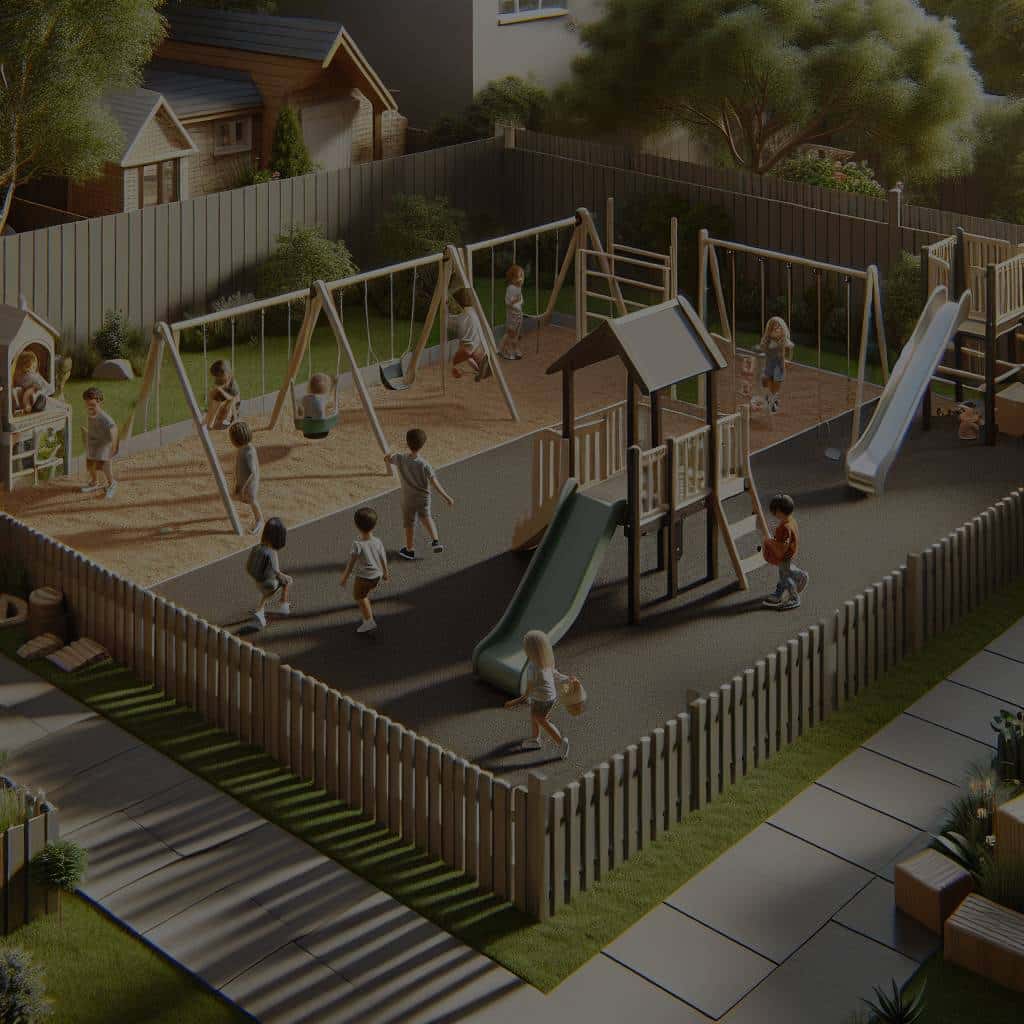What’s the Best Way to Design a Safe and Engaging Home Playground?

Designing a playground that is both safe and engaging for children can be a challenging task. It requires a careful balance between creating a space that inspires creativity and play, while also ensuring that the environment is secure and devoid of any potential hazards. The right playground design can significantly contribute to a child’s physical and cognitive development by encouraging them to explore, engage, and learn. Therefore, it’s essential to keep an eye on safety, accessibility, and learning potential while planning a playground.
Creating Safe Playground Spaces
Before even beginning to design a playground, the first aspect you need to consider is safety. A child’s safety must be your top priority. After all, a playground that isn’t safe will not be fun or engaging, no matter how exciting the equipment may be.
Also read : How to Choose Artwork That Complements the Natural Light in a Room?
The most crucial factor for safety in playgrounds is the surface material. A playground may contain the most fun and engaging equipment, but if it’s built on a hard, unforgiving surface, it can lead to injuries. Therefore, it’s vital to opt for soft, shock-absorbing materials, such as rubber mulch, wood chips, or synthetic turf, that can cushion falls and minimize the risk of harm.
Another essential safety feature is the playground equipment itself. It should be sturdy, made from durable materials, and devoid of any sharp edges or points that can cause injury. Moreover, the equipment should be age-appropriate. For instance, a climbing wall may be an exciting feature for older children, but it could pose a risk to toddlers who lack the coordination to use it safely.
Have you seen this : How to Design a Space-Saving Combined Bathroom and Laundry Room?
Designing An Engaging Environment
Creating an engaging playground involves a lot more than just buying the most exciting equipment. The playground must be a space that encourages children to play, explore, and learn.
An engaging playground should contain a variety of equipment that caters to different types of play, such as physical play, imaginative play, and sensory play. Incorporating a range of play structures like swings, slides, climbing frames, sandboxes, and water play areas can cater to various play styles and keep children entertained.
The design of the playground should also include natural elements. Studies have shown that children are more engaged in play when they’re interacting with a natural environment. Including trees, plants, rocks, and other natural elements in the playground design can enhance the play experience.
Moreover, the playground should be designed to accommodate children of all abilities. This includes ensuring the play area is accessible to children with disabilities. Ramps, wide paths, low platforms, and sensory equipment are some ways to make a playground more inclusive.
Maximizing Learning Opportunities
Playgrounds are not just a place for children to let off steam; they also present valuable opportunities for learning. A well-designed playground can support children’s cognitive, physical, social, and emotional development.
To maximize learning opportunities, consider incorporating elements that stimulate a child’s curiosity and imagination. This could involve creating themed play areas, such as a pirate ship or a castle, or including equipment that encourages problem-solving, such as a maze or a puzzle wall.
Offer opportunities for social interaction. Equipment like see-saws, cooperative swings, or sandboxes encourages children to play together, which can boost their social skills.
Choosing the Right Materials
The materials you choose for the playground can greatly impact its safety, durability, and overall aesthetic appeal.
For playground equipment, materials like plastic, metal, and wood are commonly used. Each material has its pros and cons. For instance, plastic is durable and requires minimal maintenance, but it may not look as visually appealing as wood. Metal is strong and durable, but it can get hot in the sun. Wood has a natural aesthetic appeal, but it requires regular maintenance to prevent rot and deterioration.
When choosing materials, consider factors like the local climate, maintenance requirements, and the look you want to achieve. It’s also important that the materials used are non-toxic and safe for children.
Ensuring the Playground is Accessible
Lastly, but notably, it’s essential to ensure that the playground is accessible to all children. This means that the playground design should take into consideration children of all abilities and needs.
Accessibility in playground design involves more than just adding ramps for wheelchair users. It also includes considering the various ways children with disabilities engage with their environment.
For example, a child with a visual impairment may rely more on tactile and auditory experiences. So, incorporate elements such as textured surfaces and musical equipment can help make the playground more accessible. Similarly, a child with a physical disability may require more space to navigate, so designing wide paths and open spaces can improve accessibility.
By considering safety, engagement, learning potential, materials, and accessibility in your design, you will create a playground that not only provides fun but also fosters development, inclusivity, and joy for all children.
Maintaining Active Supervision and Understanding Fall Height
Undoubtedly, it is crucial to design a safe and engaging playground, but maintaining active supervision is equally important. Active supervision involves monitoring children’s activities on the playground and intervening when necessary. Even the safest playground can become dangerous without proper supervision. Thus, adults should always be present and attentive to supervise children as they play.
Understanding and planning for "fall height," which is the distance from the highest designated play area to the protective surfacing beneath, is a vital safety measure. Fall height can determine the type and thickness of surface material required. Each piece of playground equipment has a critical fall height, and it is essential to follow the manufacturer’s guidelines. Ensuring a suitable fall height for all play equipment can drastically reduce the risk of serious injuries from falls.
Also, concerning playground equipment, it is necessary to frequently check for any wear and tear or damage. Regular inspection and timely maintenance of playground equipment can prevent accidents caused by damaged or worn-out equipment.
Fostering Gross Motor Skills and Encouraging Dramatic Play
A well-designed playground can offer children ample opportunities to develop their gross motor skills. These skills, including running, jumping, and climbing, are fundamental to a child’s physical development. Play structures such as climbing frames, swings, and slides are excellent for promoting these skills.
In addition to physical play, playgrounds should be designed to encourage "dramatic play." This type of play involves children pretending to be someone or something else, and it is crucial for their cognitive and social development. For example, a playhouse or a castle can create a setting for children to engage in role-play. This not only fosters imagination but also enhances communication skills, as children often negotiate rules and roles during dramatic play.
Conclusion: Creating a Safe and Engaging Outdoor Learning Environment
Designing the perfect playground is indeed a challenging task. However, by considering key factors such as safety, engagement, learning opportunities, the right materials, and accessibility, it is entirely possible to create an outdoor play space that is both safe and engaging for all children.
The importance of an inclusive playground cannot be overstated. It must be accessible and welcoming for all children, regardless of their abilities or needs.
Remember, the ultimate aim is to create a learning environment where children not only have fun but also learn and grow. A playground should be a place where children feel confident to explore, where they can challenge their physical abilities, engage their senses, tap into their creativity, and build social skills.
To conclude, the best way to design a safe and engaging home playground is to create an inclusive, stimulating outdoor space. One that sparks a sense of wonder, fosters learning, encourages active play, and most importantly, ensures the safety and happiness of every child. This way, the playground will provide countless hours of fun and learning for all children, enriching their childhood with valuable experiences and fond memories.
